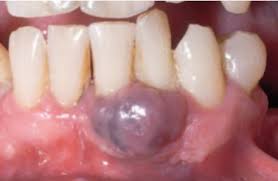Child PT. presented with swelling in the buccal and palatal maxillary anterior area 2 days ago, the pathology of the lesion there is a giant cell m what is the diagnosis?
- A. Giant granuloma =central giant cell granuloma.
- B. Hemangioma.
The diagnosis is most likely A. Giant granuloma =central giant cell granuloma.
Here's why:
- Giant cell granuloma is a benign tumor characterized by the presence of numerous multinucleated giant cells. It typically presents with a painless, slow-growing swelling in the jaws. Central giant cell granuloma is a specific type that occurs within the bone.
- Hemangioma is a benign tumor composed of blood vessels. It usually presents as a red or purple mass, often with a pulsatile quality.
Given the description of the swelling in the buccal and palatal maxillary anterior area, the presence of giant cells, and the absence of other symptoms like pain or bleeding, giant granuloma is the most likely diagnosis. However, a definitive diagnosis would require a biopsy to confirm the presence of giant cells and rule out other possibilities.
It's important to consult with a pediatric dentist or oral pathologist for a proper evaluation and diagnosis. They can provide the appropriate treatment based on the confirmed diagnosis.
Giant Granuloma: A Benign Dental Condition
Giant granuloma is a benign (non-cancerous) oral soft tissue growth. It is characterized by the overgrowth of connective tissue. While the exact cause is unknown, it is often associated with chronic inflammation or irritation.
Symptoms of Giant Granuloma:
- Lump or bump: A painless, slow-growing mass in the mouth, often on the gums or in the jawbone.
- Bleeding: The mass may bleed easily, especially if it is irritated.
- Discomfort: In some cases, the mass can cause discomfort or interfere with eating or speaking.
- Diagnosis
Treatment:
The treatment for giant granuloma depends on its size, location, and the patient's symptoms. Treatment options may include:
- Observation: If the granuloma is small and asymptomatic, it may be monitored without treatment.
- Surgical excision: The granuloma can be surgically removed. This is often the preferred treatment option, as it can prevent the growth from recurring.
- Laser therapy: Laser therapy can be used to destroy the granuloma.
- Curettage: This involves scraping away the tissue of the granuloma.
Prevention:
While the exact cause of giant granuloma is unknown, there are some steps that can be taken to reduce the risk of developing this condition:
- Maintain good oral hygiene: Brush your teeth twice a day, floss daily, and see your dentist for regular check-ups.
- Avoid irritants: Avoid smoking, excessive alcohol consumption, and other irritants that can contribute to oral inflammation.
Giant granuloma is a benign condition that can be effectively treated. If you notice a lump or bump in your mouth, it's important to see a dentist for evaluation.
Labels
Oral Surgery
